Help us continue to identify and protect birds that most need our help
In December 2020, BirdLife unveiled this year’s Red List ups and downs – with mixed results for the world’s birds.
As a global Partnership, we believe in internationalism. We have translated as much content in your language as our resources allow. Please visit the English language site to view all of our content.
Every year, over 200 species of waterbird take off from their breeding grounds across the tundra, marshes and frozen forests of northern Asia, bound to spend the winter in the balmy climates of Australia and New Zealand. Along the way, the diverse flocks converge upon the coastal wetlands of Southeast Asia to refuel on the shoreline’s bountiful worms and molluscs. These vital habitats form the heart of the East Asian-Australasian Flyway – one of the world’s major bird migration flight paths. Protecting these sites is therefore a conservation priority – but what has been achieved so far?
A new paper published in the journal Oryx, written by BirdLife and several of our national Partners, sheds light on the scale of the challenge – not least, the large gaps in basic ecological knowledge of shorebirds in the region, including where the most important sites are found. These knowledge gaps have impeded efforts to protect the most important wetlands for threatened species.
Even when important sites have been identified, action has not necessarily been taken. For instance, while 180 Important Bird & Biodiversity Areas (IBAs) across Southeast Asia contain coastal wetlands, only a small number are actually legally protected. Meanwhile, several potentially important sites for migratory waterbirds remain to be studied, and ongoing research such as satellite tracking has uncovered areas of wetland that hold threatened species, but which are entirely undocumented.
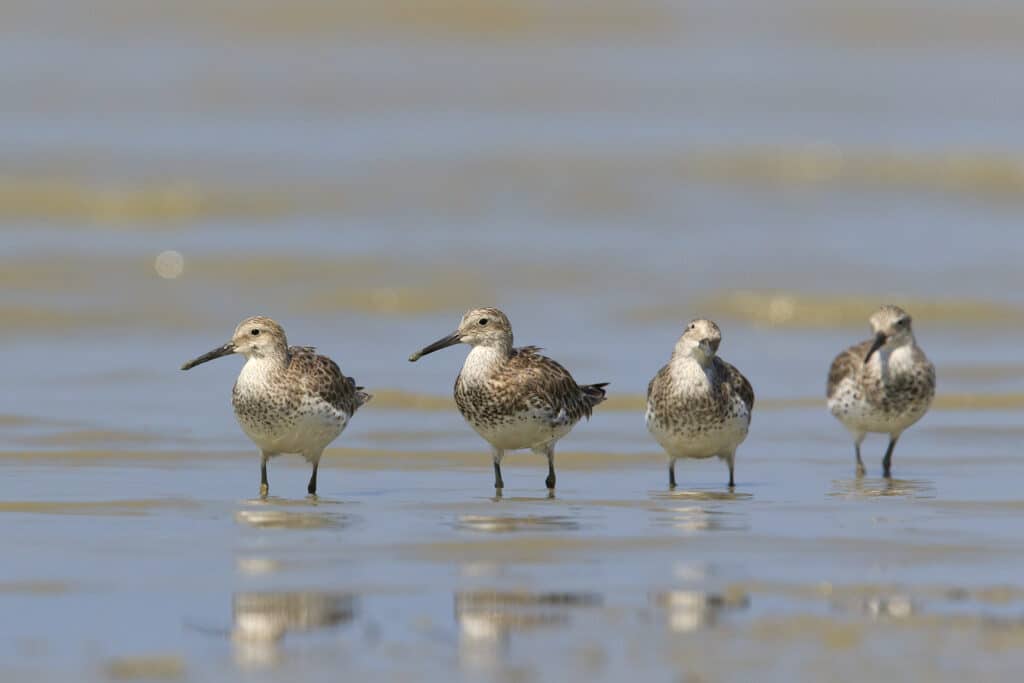
“Few – if any – of the most important sites for shorebirds – the Philippines’ Manila Bay, Vietnam’s Mekong Delta or Peninsular Malaysia’s Penang coast – are protected areas at the moment. Many of these sites are today immediately imperilled by development and may be lost in a few years if nothing is done,” said Ding Li Yong, BirdLife’s regional coordinator for migratory species conservation, and a co-author of the paper.
Coastal development and land reclamation are currently the most concerning threats, the authors noted. “Here in Malaysia, our research has identified the northern coast of mainland Penang State to be exceptionally important to shorebirds, including the Spotted Greenshank (Tringa guttifer – Endangered),” says Chin-Aik Yeap, conservation manager at the Malaysian Nature Society (BirdLife Partner), and a co-author of the paper. “However, the proposed coastal aquaculture project planned here will threaten large parts of this Important Bird & Biodiversity Area, as mangroves will be cut down.”
Nonetheless, the authors conclude that there are excellent grassroot models for migratory waterbird conservation in Southeast Asia. One of these is the Pak Thale Nature Reserve, an initiative led by the Bird Conservation Society of Thailand (BirdLife Partner) to establish a protected area for threatened shorebirds such as the Spoon-billed Sandpiper Calidris pygmaea (Critically Endangered). Under this initiative, traditional salt pans – an important roosting and feeding habitat for shorebirds – are preserved and carefully managed. Meanwhile, while local people and the government are brought together to create conservation groups and sustainable livelihoods.
“Few – if any – of the most important sites for shorebirds are protected areas at the moment.”Ding Li Yong, Flyways Coordinator (Asia), BirdLife
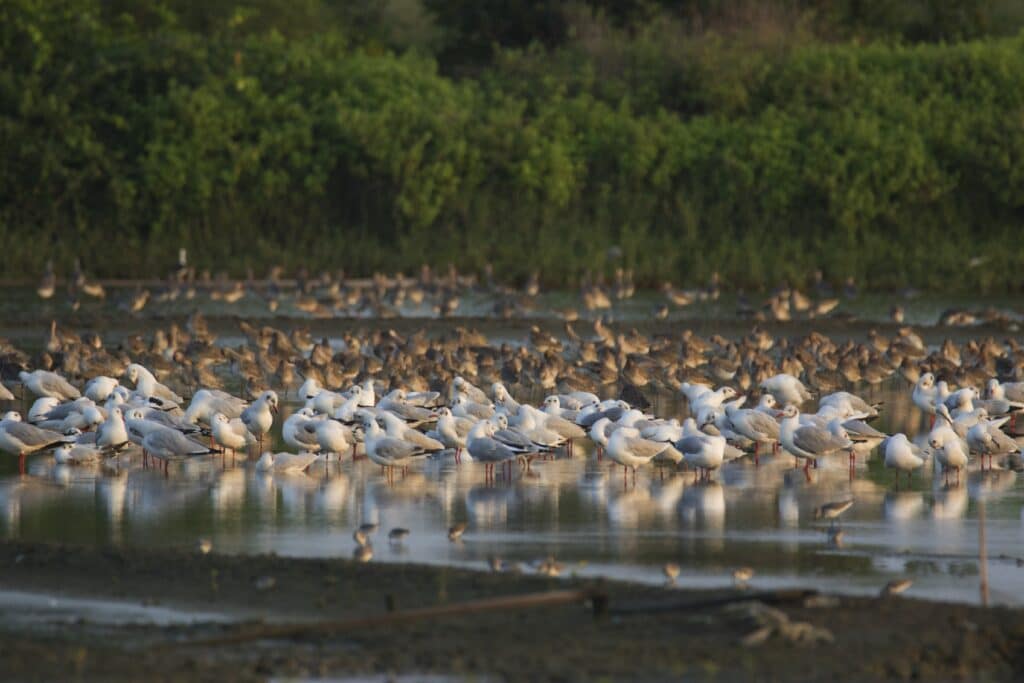
While there is considerable potential to protect Southeast Asian wetlands, there is a fast narrowing window of opportunity to mobilise conservation resources and scale up action. The recently announced Regional Flyway Initiative, led by the Asian Development Bank in collaboration with BirdLife and the East Asian-Australasian Flyway Partnership, will hopefully mobilise resources at the scale needed to secure our shared coastal wetlands and the livelihoods of people who depend on them.
“The Asian Development Bank’s Regional Flyway Initiative offers us a critical lifeline to secure these wetlands. But we need to act fast, in the next few years if possible,” says Gary Allport, BirdLife’s senior technical advisor.
Support our work today
Sign up to receive the latest bird conservation news. You’ll also receive updates about our projects, science and other ways to get involved including fundraising.
Thank you for your support, we are committed to protecting your personal information and privacy. For more information on how we use your data, please see our Privacy Policy. You can unsubscribe from emails at any time by using the link in the footer of any email from us.


Across Africa, vulture populations have catastrophically declined over the last 50 years, with overall decline rates of up to 97%. Today, 7 out of 11 African-Eurasian vulture species are at risk of extinction, underlining this decline. Leading causes of vulture mortalities on the continent include poisoning, belief-based use and collision with energy infrastructure among other factors. In West Africa, belief-based use is considered the leading cause of vulture deaths, where vultures are killed for their parts which are used in traditional medicine or charms. In 2020, more than 2000 Critically Endangered Hooded Vultures Necrosyrtes monachus died in Guinea Bissau, with the deaths linked to belief-based use, while in Gambia, more than 50 Hooded vultures were poisoned in the same period. Currently, the Hooded vulture is classified as Critically Endangered on the IUCN Red List, further underlining the significance of this threat.
In 2021, a vulture conservation project was launched in Guinea Bissau, the Gambia and Senegal to address threats to vultures in the region. The project supported by IUCN Save Our Species , and co-funded by the European Union is being implemented by Organização para a Defesa e Desenvolvimento das Zonas Húmidas (ODZH) in Guinea Bissau, WABSA, West African Bird Study Association in the Gambia, and Nature-Communautes-Developpement (BirdLife Partner) in Senegal. Several activities have been undertaken in all countries over the course of the first half of this year-long project attempting to understand the drivers and motivations behind the use of vulture parts. In Senegal and Gambia in particular, there has been a concerted focus on vulture monitoring surveys and sensitization campaigns.
Capacity building is a crucial aspect of this project. To this end, ODZH is carrying out capacity building training targeting law enforcement officers working at checkpoints and judges in three regions namely Bissau, Bafatá and Gabú, to address wildlife crime particularly poisoning of vultures in Guinea Bissau.
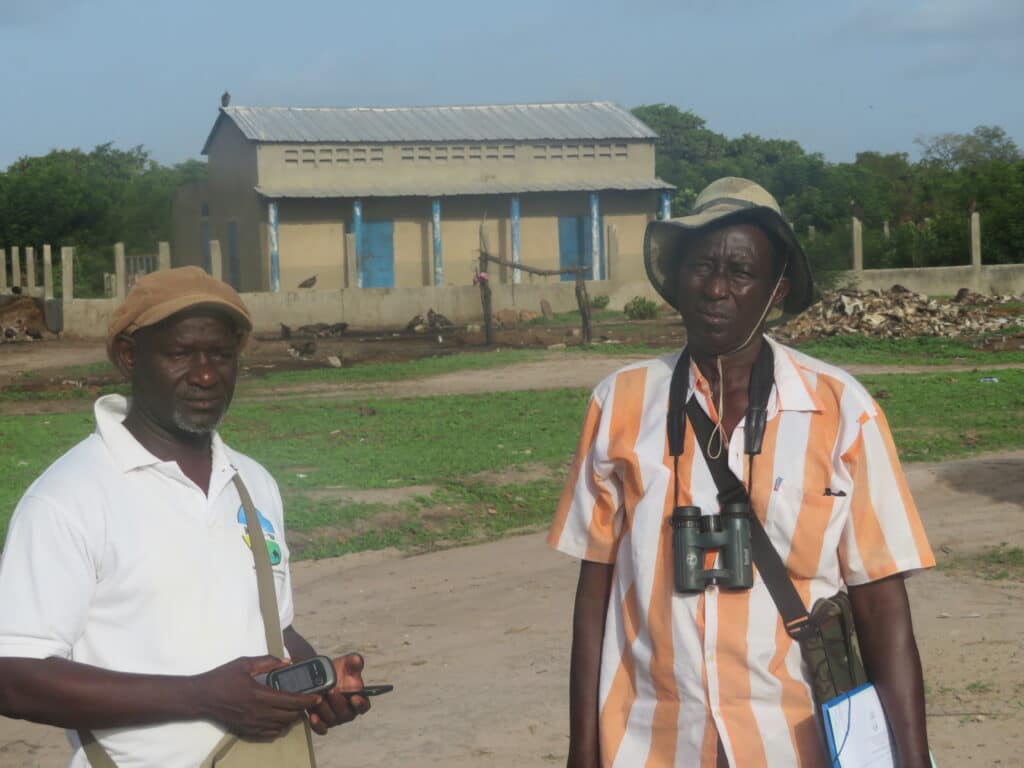
Countrywide Surveys
Another key element of this project is carrying out vulture surveys to determine vulture populations in these countries and to understand where vulture parts may be being sourced within the country. In the Gambia, WABSA successfully conducted a countrywide survey of vultures. A total of 4892 hooded vultures and 21 White-Backed Vultures Gyps africanus were recorded over a distance of 970 km, with sightings mostly recorded in settlements and farmlands.
“Vultures play a key role as they help clean carcasses from the environment, thereby likely reducing transmission of diseases. Besides carcasses, vultures also feed on prey such as lizards, smaller birds and rodents, an aspect that has reduced poisoning cases in the country ,“ notes Fagimba Camara, senior research officer at WABSA.
Since the inception of the project, NCD has carried out vulture surveys in eight target sites in Senegal, with monthly monitoring ongoing at five of these sites. Further, market surveys have been carried out in these sites, to help understand the regional drivers of vulture part use in the country. NCD project implementation teams have undergone training on vulture monitoring at the regional sites.
“Vultures play a key role as they help clean carcasses from the environment, thereby likely reducing transmission of diseases.”
Fagimba Camara, senior research officer, WABSA
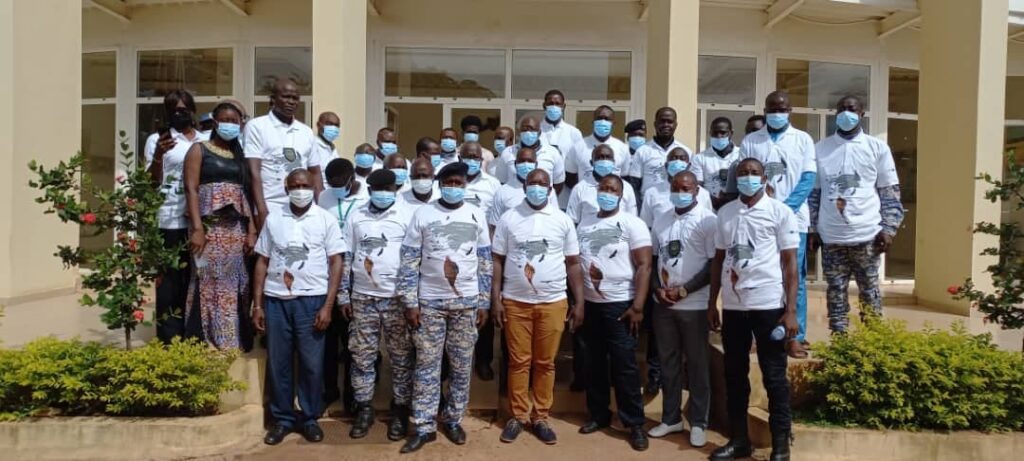
Awareness-raising Campaigns
While vultures provide important ecological services, public awareness on the role of these endangered birds remains low. Consequently, WABSA is carrying out sensitization campaigns on vultures, targeting abattoir managers, livestock owners, traditional healers, butchers, and meat vendors in addition to public health officers. Through these outreaches, it is hoped that the local communities will understand and appreciate the unique role played by vultures in the environment, consequently promoting conservation efforts. Further, WABSA is carrying out sensitization through radio programs on vultures, targeting a wider audience. Additionally, weekly market surveys are being carried out in Gambia’s five regions, to establish the scope of vulture parts trade in the country. As the project implementation progresses, WABSA aims to continue vulture monitoring and carrying out more sensitization campaigns in the country.
ODZH is carrying out sensitization campaigns in Bijagós, Bafatá, Gabú, Buba and Cacheu regions through radio programs on wildlife crimes including vulture poisoning in Guinea Bissau and the West African sub-region. Additionally, sensitization campaigns in four communities in Bafatá and Gabú are ongoing in collaboration with Project Rufford. On its part NCD, will seek to scale up vulture monitoring to national level in addition to awareness raising, and advocacy for vulture protection in legislations. In addition, a comprehensive study of vultures in the country is planned, including a census of the species, and identification of breeding sites. Through these interventions, it is hoped that the project will go a long way in addressing vulture threats in the three countries.
This publication was produced with the financial support of the European Union through IUCN Save Our Species. Its contents are the sole responsibility of BirdLife International and do not necessarily reflect the views of IUCN or the European Union.
Sign up to receive the latest bird conservation news. You’ll also receive updates about our projects, science and other ways to get involved including fundraising.
Thank you for your support, we are committed to protecting your personal information and privacy. For more information on how we use your data, please see our Privacy Policy. You can unsubscribe from emails at any time by using the link in the footer of any email from us.


By Rachel Gartner
There are many things that assault your senses when you visit Southern Patagonia. First the wind, vicious and constant, which blows your glasses off your face, the hat off your head and, if you’re not careful, blowing you off the narrow path you happen to be walking along. Then there is the landscape. Grassy, dry, treeless plains that stretch for miles, until they hit the Andes, which seem to appear out of nowhere and take your breath away with their craggy, snowy peaks.
Finally, there is the wildlife. Guanacos (a close relation to llamas) grazing, skittish rheas with their young trailing behind them in an orderly line, scaly armadillos vacuuming insects from the ground. In the distance, Patagonian foxes sniff the air intently in search of their next snack, and pumas silently stalk. But perhaps most striking of all, the condors, soaring high above you, circling for carrion. If you’re really lucky, you might get to see them on the ground, hopping around a guanaco carcass, their intelligent and surprisingly handsome bald faces poking up above their feathery shoulders.
Like seeing the Andes for the first time, witnessing an Andean Condor Vultur gryphus in its natural habitat is a breath-taking experience. And one that may soon be denied to many. Unfortunately, our recent Red List update shows that the fate of the Condor across its entire range is looking increasingly bleak. If we don’t act soon, these majestic birds, who are so much a part of the Andean landscape, might be lost forever.
While the number of Condors is decreasing across the entire continent, populations are smallest in the northern part of their range. There are fears that the species is now extinct in Venezuela, and there are only around 7,000 adults left across its range. “The Andean Condor is built to last. But humans are ruining its natural ‘live slow, die old’ life strategy, causing high death rates from which it is hard to recover,” says Ian Davidson, our Director in the Americas.
For anyone who has been following our coverage of the vulture crises affecting Asia, Europe and Africa, the threats facing condors will no doubt sound eerily familiar. Poisoning (both intentional and accidental) is at the top of the list, but condors are also being affected by habitat loss, illegal hunting and wildlife trade, competition for food from feral dog populations and collisions with energy infrastructure.
Most concerningly, there have been several mass poisonings reported in the last few years. Many ranchers across the region coat livestock carcasses in illegal organophosphate pesticides and other chemicals to ward off potential predators like pumas, foxes and feral dogs. In 2018 alone, over 120 Condors were confirmed to have been killed by poisoning, with one event in Argentinian Patagonia accounting for 23 deaths. This practice is not just harmful to condors, but all wildlife.
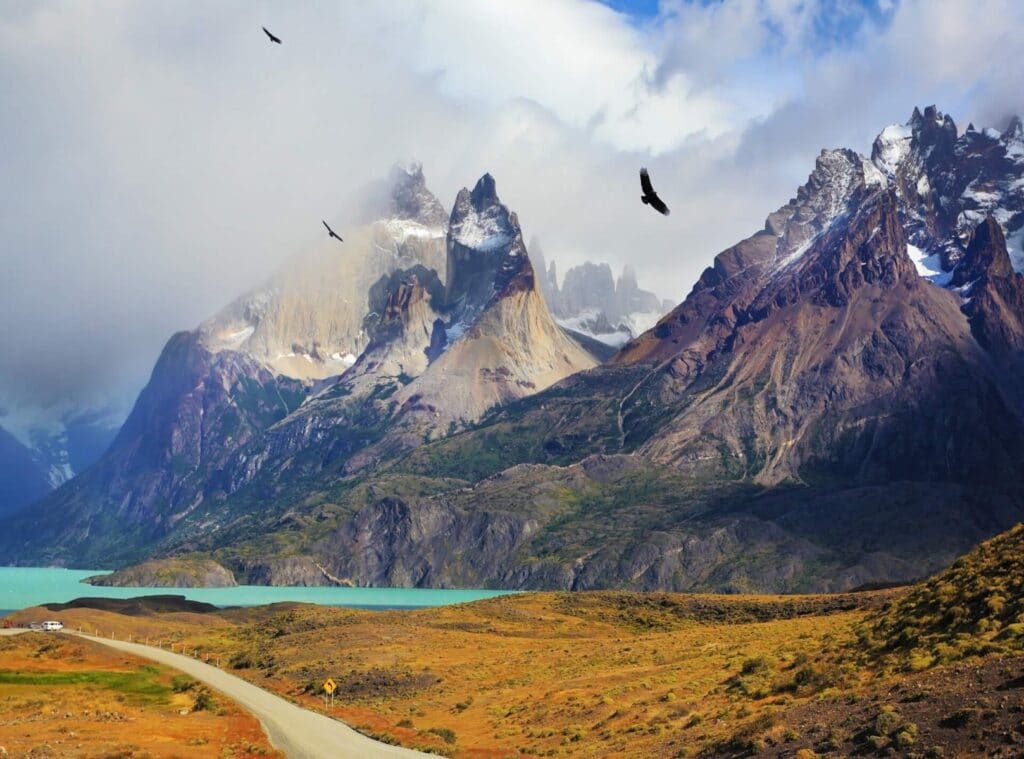
The impact of these combined threats on Old World vultures has been significant and serious. In Asia, vulture populations plummeted by 99% over a 20-year period because of the use of NSAIDs – drugs which are deadly to Old World vultures – in cattle farming. In Africa, seven vultures are threatened with extinction. If a similar pattern emerges in the Americas, the result would be catastrophic.
There is hope though. Our work to protect Old World vultures has shown that decisive and targeted action can be successful. Following a blanket ban on NSAIDs and the implementation of vulture safe zones in several Asian countries, vulture populations in the region are now showing signs of stabilising. In addition to banning harmful drugs and chemicals (and effectively enforcing these bans), the best tools in our arsenal to protect condors are increased habitat protection, awareness raising and education. And encouragingly, there are already a number of Condor conservation programmes up and running in South America.
The Andean Condor Working Group, established in 2012, brings together the efforts of a number of organisations focused on protecting condors in the region. Aves y Conservación (BirdLife in Ecuador), as a member of the Ecuador Working Group, has been participating in monitoring populations through a nationwide census and building awareness. A dedicated reserve was also set up by the Jocotoco Foundation in 2014, and there have been several successful releases in the country. Asociación Armonía (BirdLife in Bolivia) has also been actively engaged in monitoring condor populations and building awareness through education programmes in the community.
The Condor’s change in Red List status to Vulnerable provides us with a clear message that we need to scale up these conservation activities, and do more work to protect the species across its entire range. Acting quickly, we have the opportunity to avoid the same scale of crisis that has affected Old World Vultures.
At the crack of dawn on a typically chilly Patagonian morning a few years ago, your writer gathered with a number of other excited onlookers to watch the sun rise over the Fitz Roy mountain range in Argentina. As the sunlight coloured the mountains in a bright pink glow, the group was distracted by a condor taking flight, soaring higher and higher until it vanished out of view. The thought that this spectacle might become increasingly rare, or disappear altogether, is unspeakably sad – but not inevitable.
When did the condor’s plight first appear on your radar?
We were the first organisation to launch a campaign to save the condor in Ecuador in the 1990s. We’ve been involved in helping to monitor Condors through the national census.
What measures have been instrumental in helping you gauge the extent of the situation?
Radio tracking – led by the Peregrine Fund and Fundacion Condor – has been crucial to building a better understanding of the species within Ecuador. For example, this tracking has shown us that the majority of condors are not within protected areas.
What are the next steps for condor conservation?
Environmental education is probably one of the most important activities that we need to focus on. In addition to building awareness with students and local communities – which we’ve done very successfully – we need to educate governments and decision-makers, since they have the power to make significant changes to help protect this species. In the future, we would like to create a Condor booth, a mobile education unit that can be easily taken into communities around the country.
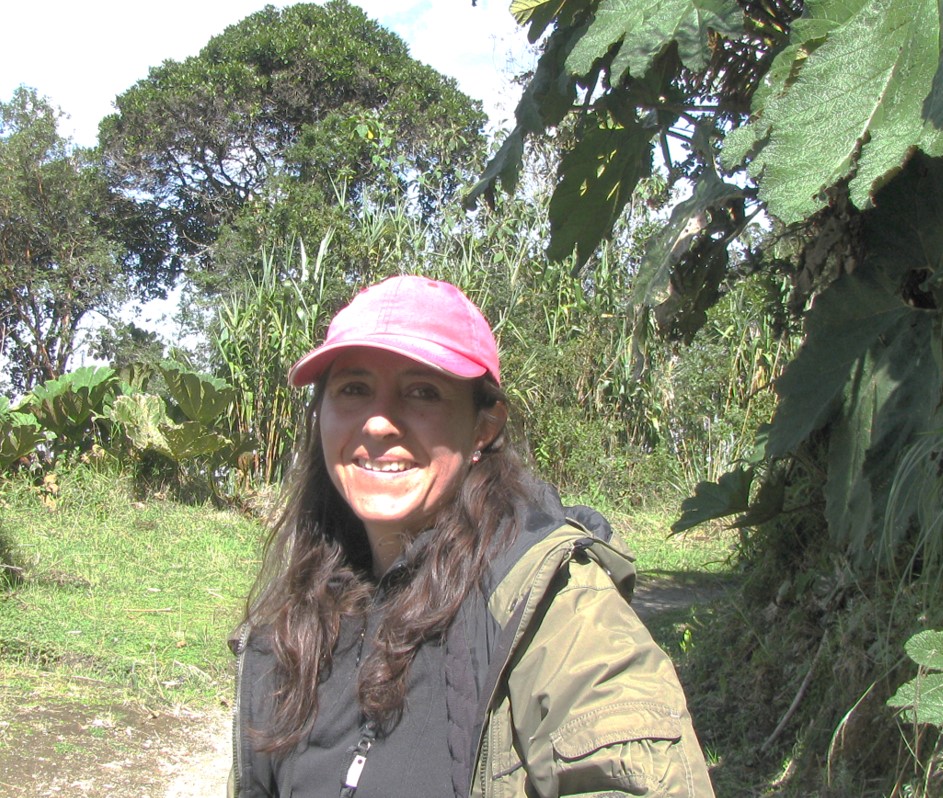
In December 2020, BirdLife unveiled this year’s Red List ups and downs – with mixed results for the world’s birds.
As one of BirdLife’s Red List researchers, Claudia Hermes has the inside track on the avian trends that are cause for most concern. And there’s one group in particular that keeps her awake at night. “I’m really worried about parrots in Latin America and the Caribbean.”
Judging by the 2020 IUCN Red List update, her concern is warranted. A further four parrot species from the new world tropics were uplisted to a higher threat category in the update, meaning that now, over half the region’s parrots are classified as Near Threatened, globally threatened or extinct – a proportion double the global figure. And this may represent only the tip of the iceberg: Hermes already envisages that further parrots from the Caribbean and Central America will be uplisted next year.
This year’s uplisted quartet – comprised of two amazons, a macaw and a parakeet – are essentially facing the same set of threats, which Hermes describes as a combination of habitat loss and direct persecution or trade. But their uplisting also reflects improved understanding of avian ecology. Ornithologists recently recalculated generation lengths for all birds, prompting BirdLife’s Red List team to re-evaluate species against the IUCN criterion governing the rate of population decline across three generations. “For many amazons and macaws, generations transpire to be longer than we understood,” says Hermes, “so a species’ population decline over, say, a revised duration of 50 years, is more profound than when we thought three generation lengths were a decade shorter.”
This impact of this ostensibly technical point is particularly perturbing when combined with new information revealing populations are lower than assumed. This is the case for Great Green Macaw Ara ambiguus, now uplisted to Critically Endangered. Alarm bells were already ringing following calculations of a 34% decline over three generations in Ecuador and a 99% crash over the same period in Nicaragua/Costa Rica – the consequence of pressures such as habitat disturbance, including selective logging of a favoured nest tree, and trade. But the gamechanger was a shocking revelation that numbers in the presumed stronghold of Colombia were just one-tenth of the previous reckoning.
The second newly Critically Endangered parrot is a relative new kid on the block. Lilacine Amazon Amazona lilacina appeared on conservationists’ radar as recently as 2014, when BirdLife judged the Ecuadorian endemic to be a different species from the widespread Red-lored Amazon Amazona autumnalis. Although surveys over the past couple of years suggest there are more Lilacine Amazons than thought, data also suggest that numbers have declined by at least 80% over three generations. The main threat is illegal hunting for domestic pets: research published in 2020 predicts that the majority of local communities keep captive Lilacine Amazons. The problem is all too common. Sadly, the birds’ beauty – and human weakness for colourful creatures – is intrinsic to their downfall.
By James Lowen
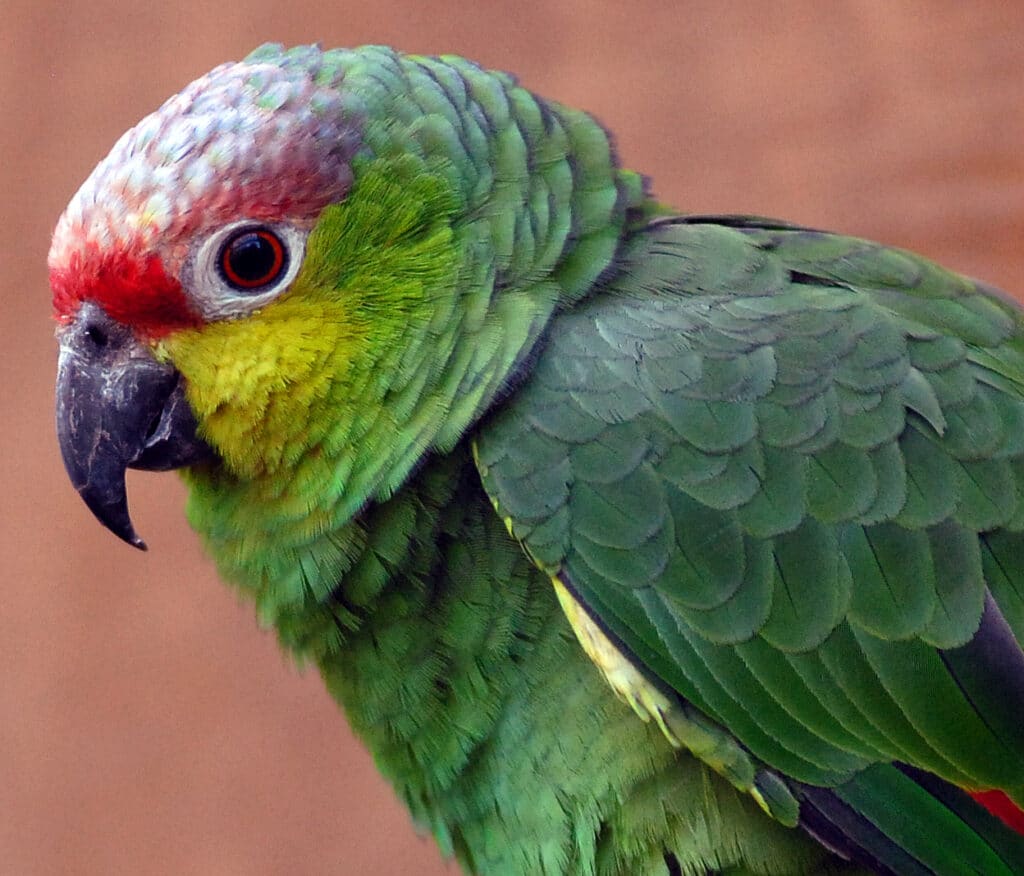
This is also true of Orange-fronted Parakeet Eupsittula canicularis, which occurs from Mexico to Costa Rica. One of Central America’s most abundant parrots, with an ability to adapt to deforestation and even tolerate urban areas, this wasn’t an obvious candidate for globally threatened status. Awareness of the scale of trapping changed all that. An estimated 570,000 individuals were illegally captured across the 25 years to 2019, particularly during the first half of that period. This suggested a population decline of up to 41% over three generations. Little wonder that our researchers catapulted this attractive parrot from Least Concern to Vulnerable.
At the margin, trade also affects Black-billed Amazon Amazona agilis. Endemic to Jamaica, this parrot has been uplisted from Vulnerable to Endangered. The impact of poaching has exacerbated the principal pressures of habitat destruction (notably a bauxite-mining concession), predation by invasive species such as rats and snakes, and, above all, climate change. “Climate change messes up everything”, says Hermes. “As an example, changes in rainfall patterns affect fruiting trees, which makes it harder for breeding adults to find food.” Sometimes this forces birds closer to villages – which heightens the risk of being captured.
For species imperilled by the climate crisis, it can be hard to know what tangible conservation actions to suggest. Tentative proposals for Black-billed Amazon include protecting forest, implementing environmental education programmes and captive breeding. For other uplisted species, the way forward is a little clearer. In pockets of its range, Great Green Macaw is being helped – by Costa Rica’s Macaw Recovery Network, Colombia’s Fundación ProAves and Ecuador’s Fundación Jocotoco – through research, habitat protection, community engagement and reintroductions. More such action is needed, and more widely.
Meanwhile, thanks to enforcement of Mexican legislation banning trade, the deleterious impact of harvesting wild Orange-fronted Parakeets seems to be a thing of the past. Nevertheless, it will take years to ascertain whether the moratorium is sufficient to return the species to a lower category of threat. For Lilacine Amazon, the solution – alongside initiatives such as the reserve expansion with which the American Bird Conservancy (ABC, a BirdLife Partner in the US) is supporting Fundación Jocotoco – may lie in helping local communities convert their love of parrots into efforts to keep wild birds safe.
This all seems a lot to hope for particularly when, as Hermes admits, “time is running out to find solutions for these species”. But experience from BirdLife’s Americas Partnership and beyond suggests that positivity in justifiable.
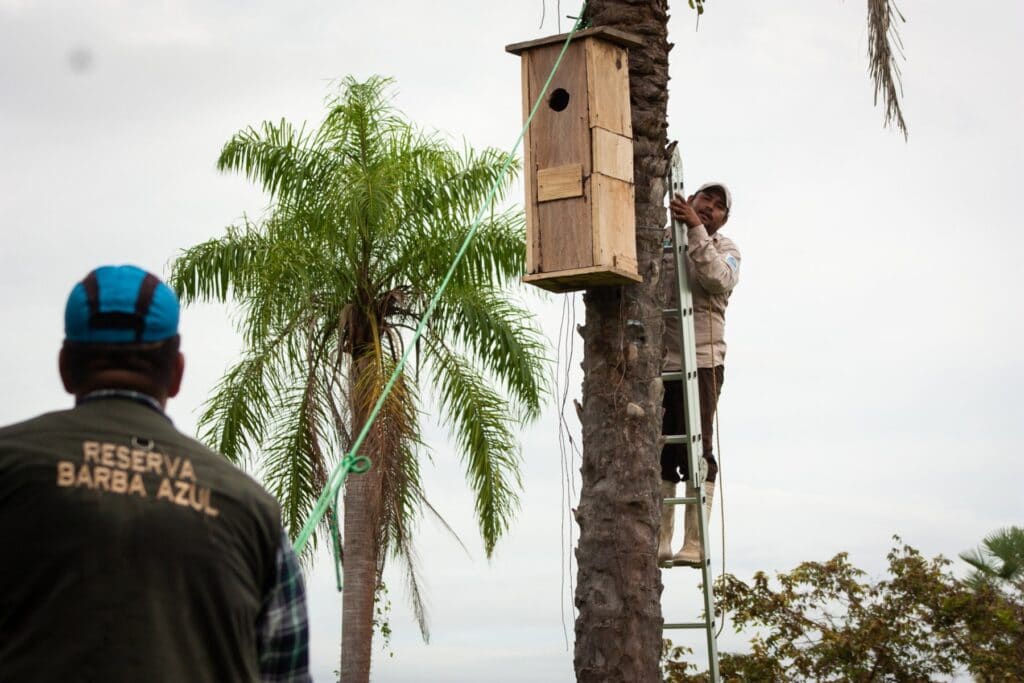
In Bolivia, BirdLife Partner Asociación Armonía – again with ABC backing – has long strived to rescue remnant populations of the Critically Endangered Blue-throated Macaw Ara glaucogularis (Critically Endangered). Armonía’s Barba Azul Nature Reserve protects seasonally important foraging and roosting sites for over a hundred macaws. In November 2020, the Bolivian government declared the protected area a ‘Private Natural Heritage Reserve’ – the first designated anywhere in the country in nine years.
“Our next challenge is to get macaws breeding there, so we protect their entire lifecycle”, says Tjalle Boorsma, Armonía’s Conservation Programme Director. There are strong grounds for hope: at Armonía’s Laney Rickman reserve, a nest-box programme has fledged 93 birds since 2005. Just as excitingly, Armonía’s discovered three previously unknown Blue-throated Macaw breeding site during a 2020 survey of remote savannah grasslands. The resulting moderate population increase, to 312–455 birds, is building confidence in a sustained recovery.
As well as Blue-throated Macaw and Lilacine Amazon, Dan Lebbin (ABC’s vice-president for Threatened Species) says that twelve globally threatened or Near Threatened parrots have been the focus of targeted ABC conservation projects and programmes across Latin America and the Caribbean. These include helping Fundação Biodiversitas protect the most important colony of Lear’s Macaw Anodorhynchus leari. Thanks to conservation efforts, this Brazilian endemic recovered sufficiently to be downlisted from Critically Endangered to Endangered in 2009.
Roughly 80 other species have benefited from habitat protection across ABC and partners’ reserve network, including those of BirdLife Partners SAVE Brasil, Bahamas National Trust and Grupo Jaragua (BirdLife in the Dominican Republic). In 2019, ABC also established the Parrot Conservation Alliance, bringing together animal-rescue sanctuaries with environmental organisations to support wild-parrot conservation programmes in Latin America and the Caribbean. ABC’s experience, Lebbin says, “proves that conservation can reverse parrot declines”.
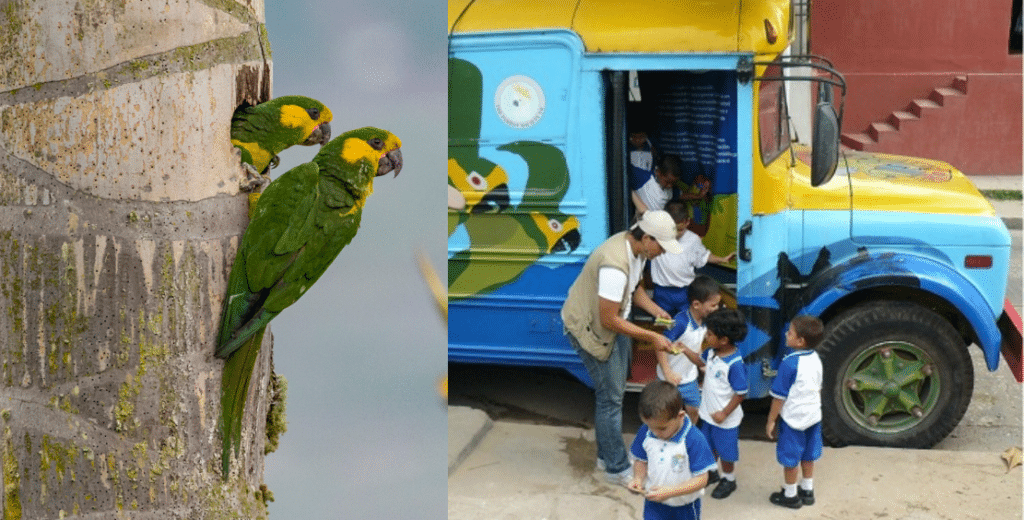
Lebbin could equally have lauded another ABC-supported parrot success story brightening the latest Red List update. The fifth New World parrot to feature does so, thrillingly, because it has been downlisted. No longer is Yellow-eared Parrot Ognorhynchus icterotis Endangered, a remarkable feat given that barely 20 years ago, just 81 birds were left, all in Colombia. Subsequent work, led by Fundación ProAves (whose logo features the parrot) and Loro Parque Foundation, has returned spectacular dividends. By 2019, the parrot’s population had reached 2,601 birds, prompting its new categorisation as Vulnerable. For a species deemed Critically Endangered until 2010, this is an extraordinary turnaround.
Habitat protection and restoration, plus a ban on using wax palms in Palm Sunday celebrations and a successful public-awareness campaign, have all contributed to preventing this parrot’s extinction. Paul Salaman, who initiated the project, is particularly proud of the strength of community involvement, saying that “the dire plight of the Yellow-eared Parrot unified a nation to work collaboratively to save the species”. So resounding is the turn-around in this parrot’s fortunes that Salaman believes the Yellow-eared Parrot’s recovery “offers hope that we can make a difference even in the face of great adversity.”
However unsettled she may be about the parlous status of New World parrots, Salaman’s sentiment is one that Claudia Hermes can share. “As long as we react and get things done, all is not yet lost. There remains hope.”
In December 2020, BirdLife unveiled this year’s Red List ups and downs – with mixed results for the world’s birds.
By Jessica Law
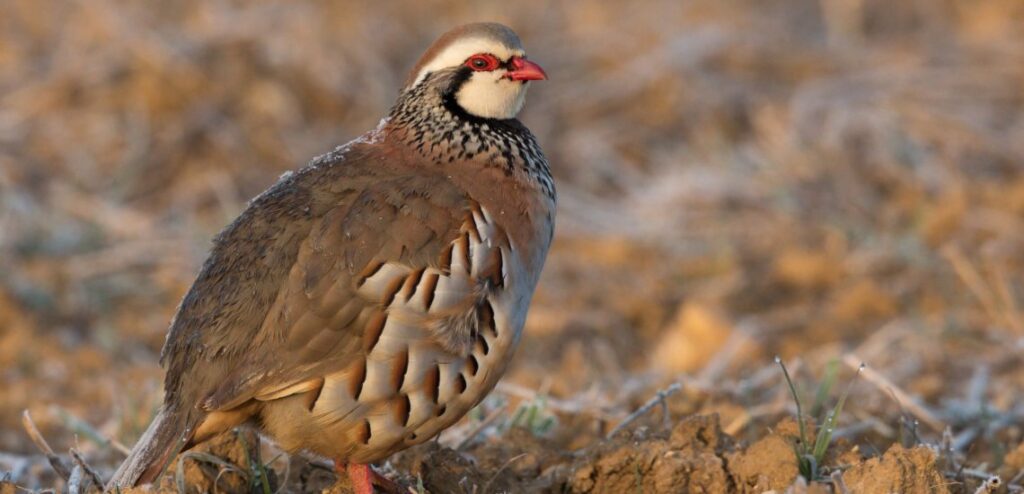
This might not be the Christmas news you want to hear, especially in 2020. But this year, another bird species from the popular carol “The Twelve Days of Christmas” has been reclassified to a higher threat category on the IUCN Red List. The Red-legged Partridge Alectoris rufa, a colourful, instantly recognisable gamebird, has been classed as Near Threatened in this year’s update. The other bird named in the carol is the European Turtle-dove Streptopelia turtur, listed as Vulnerable since 2015. Both species are thought to be declining for similar reasons, including agricultural intensification, habitat loss and unsustainable hunting.
Although the Red-legged Partridge is commonly seen on farmland across southwest Europe, agricultural practices are becoming more and more intense, homogenising the mosaic of different habitats it needs to nest and feed. These include field margins, hedgerows and orchards (including pear trees!). Over-hunting probably had a hand in this, too: according to recent research, over 60% of its estimated population may be shot each year – just another sign that we desperately need to make both farming and hunting practices more sustainable.
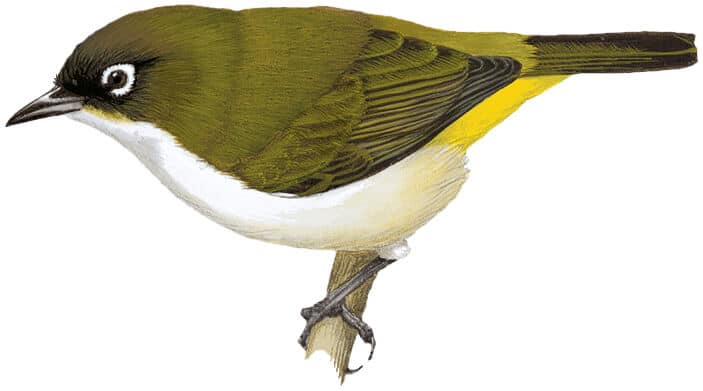
Vanatinai Island, also known as Tagula, is a remote volcanic island in the southwest Pacific, 360 km southeast of Papua New Guinea. With its dense wooded mountain range jutting through smoky wisps of cloud, it resembles Jurassic Park, and for many years its bird species were as mysterious as the dinosaurs they evolved from. Due to the island’s remote, inaccessible landscape, little scientific research had been conducted, and until now some species have been classed as “Data Deficient” on the Red List.
This year, for the first time, we now know enough to properly assess the status of three species: the Tagula Honeyeater Microptilotis vicina, Tagula Butcherbird Cracticus louisiadensis and Tagula White-eye Zosterops meeki. And it looks like we’ve done so just in time, because two of the species – the Tagula Butcherbird and Tagula White-eye – are Near Threatened. Logging, agricultural expansion and commercial gold prospecting are destroying their rainforest habitats. These vital new discoveries came in large part from research lead by one scientist, William Goulding, whose ambition is to improve knowledge of all the endemic bird species of Tagula and the wider Louisiade Archipelago. His research projects employ and train local people and include public education and awareness-raising campaigns among island communities.
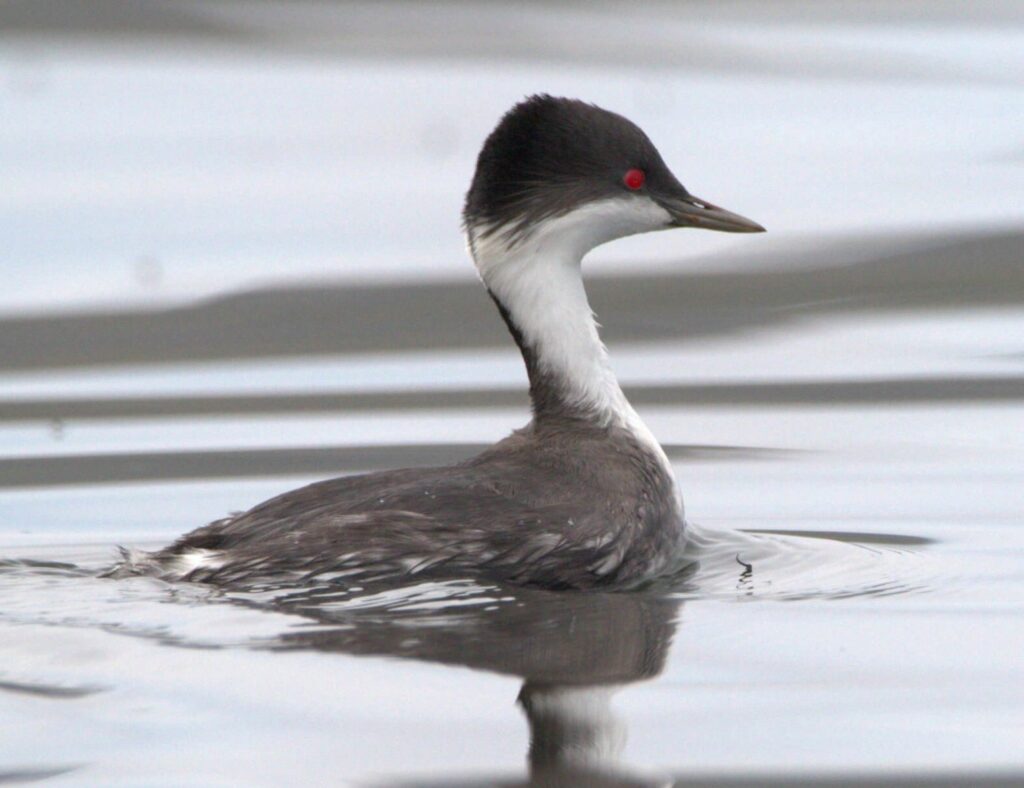
Another species came off the Critically Endangered list this year thanks to the hard work of scientists, government agencies and local people. The Junín Grebe Podiceps taczanowskii is a unique, flightless diving bird found only Lake Junín in the Peruvian highlands. Sadly, in the 20th century, the home it had adapted to so perfectly became a polluted prison, degraded by runoff from mining activities and sewage. Worse, its nesting areas would suddenly and fatally dry out as water was extracted to supply hydroelectric plants. By 1993, just 50 birds survived, and the fate of the entire species hung in the balance.
Thankfully, its plight did not go unnoticed. The lake was designated a Ramsar wetland of international importance and an Important Bird & Biodiversity Area, and in 2002 the Peruvian government passed an emergency law to clean large areas of water and place greater restrictions on water extraction. As part of BirdLife’s High Andean Wetland project, we helped Peruvian conservation group ECOAN to set up long-term research and community education programmes. The species has become a flagship for High Andean Wetland conservation, and while the tide hasn’t completely turned – it is still Endangered – it is definitely heading in the right direction.
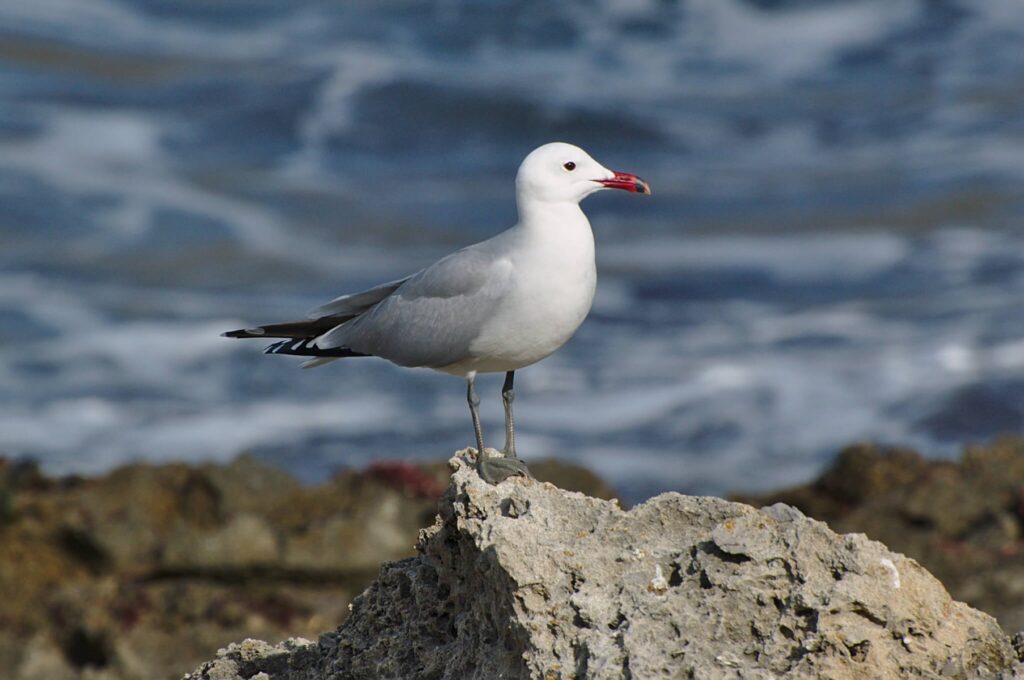
Following a population increase and range expansion in recent decades, nobody expected that Audouin’s Gull Larus audouinii, a well-known Mediterranean seabird, would again become Vulnerable to extinction. Alarm bells began ringing when researchers reported the collapse of its largest breeding colony, at the Ebro Delta in northeast Spain, after several years of very low breeding. Although some birds are relocating and forming new colonies, overall numbers have been in steep decline since 2010 – which is what you might expect when the site that hosted two-thirds of its global population becomes unliveable.
So, what happened at the Ebro Delta? It seems to be a combination of factors, all of them manmade. On land, the loss of suitable habitat meant that, when predators started to naturally increase around the breeding site, the gulls had nowhere else to flee to. Indeed, many of the relocated colonies are in suboptimal habitats such as shipping ports. Problems also persist out at sea. Unusually for large gulls, Audouin’s Gull is a specialist fish eater rather than a scavenger, so is threatened by overfishing. The species is also a common victim of accidental “bycatch” by fishing vessels. And although we don’t yet know the full picture, this year’s Red List update has shown us where to look.
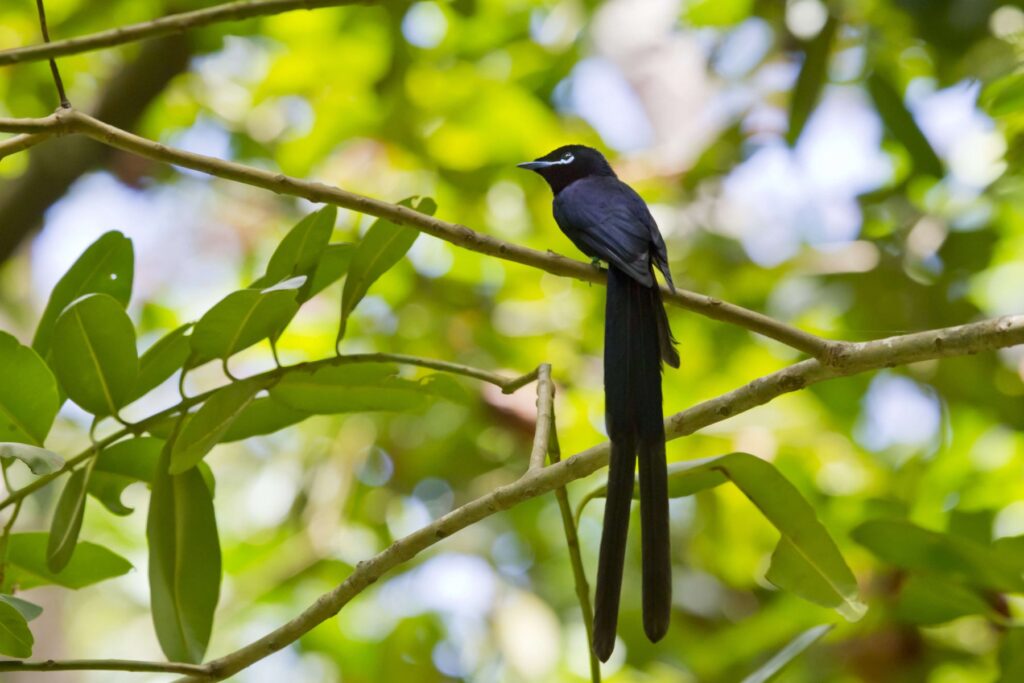
Great news for the Seychelles Paradise-flycatcher Terpsiphone corvina, a stunningly iridescent songbird, whose name, Terpsiphone, means “delightful voice” in Greek. As of this year, the species is no longer considered Critically Endangered. Formerly confined to La Digue island in the Seychelles, its population has steadily increased over the past two decades and has been successfully reintroduced to another part of its former range, Denis Island. The new colony is growing and thriving, and the flycatcher’s melodious, whistling call can be heard throughout the island’s forests, which are now predator-free thanks to an ongoing habitat restoration programme. A third population was introduced to Curieuse Island in 2018-2019, and has already started breeding successfully.
This heartening success is the result of years of hard work by Nature Seychelles (BirdLife Partner) and its collaborators. Together, they established a nature reserve from scratch, together with an education centre and a large-scale public awareness campaign. This included a drive to set up water baths at schools and community centres, to help all birds survive the dry season. The flycatcher is still classed as Vulnerable, and much of its habitat is still threatened by development projects, but its home is at least one step closer to paradise.
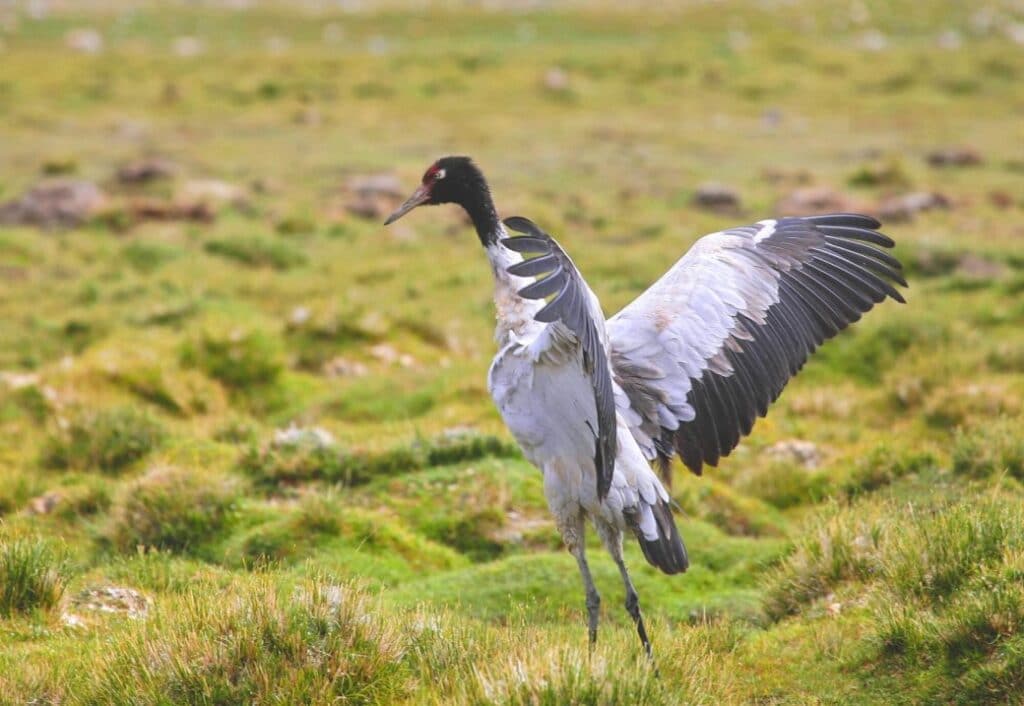
The Black-necked Crane Grus nigricollis has moved one category closer to safety this year, from Vulnerable to Near Threatened – a shining example of the power of protected areas and habitat restoration. This majestic waterbird makes its home on the wetlands of the Tibetan plateau in western China, as well as adjacent parts of northern India and Bhutan. Over the years, this habitat has been encroached on by intensive agriculture and urbanisation.
Fortunately, there is already a lot of love for the bird in the community. It is revered in Buddhist traditions, and culturally safeguarded across much of its range. And while the birds are wary of humans, they sometimes become accustomed to local people who do not disturb them. In fact, according to findings from the BNHS (BirdLife in India), the cranes appear to be able to distinguish people in traditional dress, and are especially wary of others. This presented the unique opportunity to raise awareness and engage local people in the bird’s protection. Every year in November, Bhutan holds a festival to raise awareness of crane conservation, and the Black-necked Crane is the state bird of Jammu and Kashmir, India. With a recovering population and nature reserves being respected, the future looks bright.
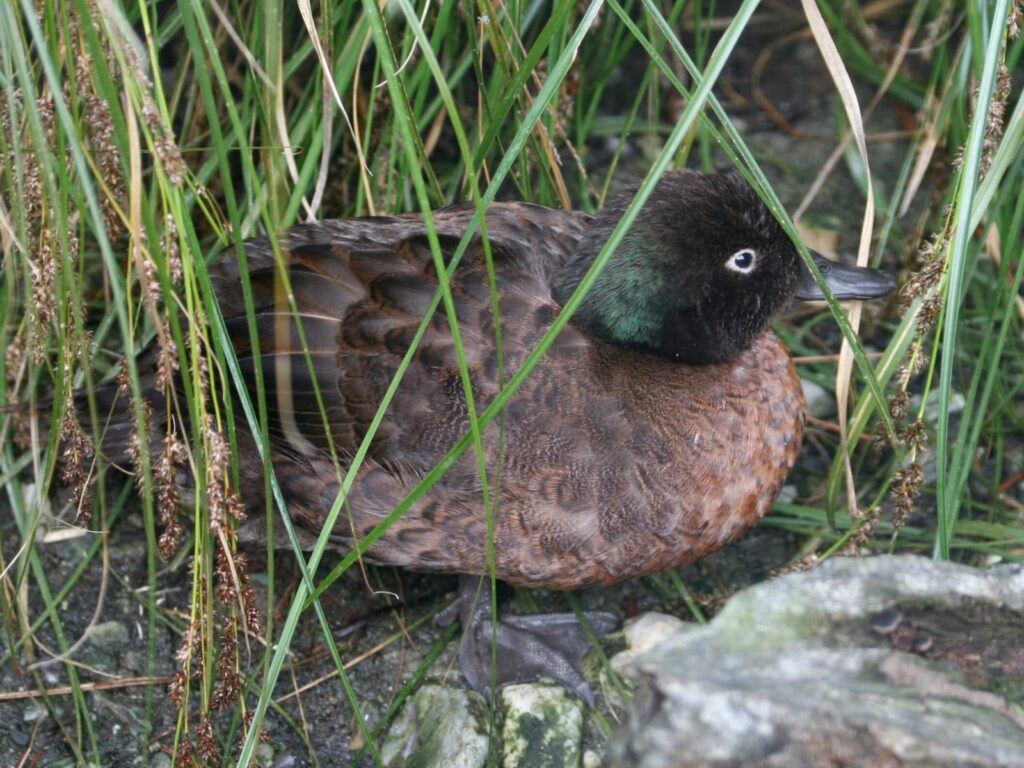
This year, the Campbell Teal Anas nesiotis becomes another success story in New Zealand’s ongoing ambition to control invasive species and restore its habitats’ natural equilibrium. Unusual in that it is both flightless and nocturnal, this small, iridescent dabbling duck has been reclassified from Endangered to Vulnerable. This is particularly impressive since it was thought extinct for many years after being wiped out by Brown Rats on its native home, Campbell Island, 700 kilometres south of mainland New Zealand. However, in 1975 it was rediscovered on Dent Island, a tiny nearby islet that had remained rat-free. The race was now on to restore this small, fragile population to its former range.
After much trial and error, conservationists successfully got this choosy bird to breed in captivity. An “insurance population” was released on Codfish Island, which was already pest-free and intensively managed for the Kakapo Strigops habroptila (Critically Endangered). Restoring the larger, remoter and more rugged Campbell Island was a far more ambitious affair, with the New Zealand Department of Conservation using helicopters to drop bait across the whole island. In 2004, after almost a century away, the species was brought back home, and has been thriving ever since.
In December 2020, BirdLife unveiled this year’s Red List ups and downs – with mixed results for the world’s birds.
Sign up to receive the latest bird conservation news. You’ll also receive updates about our projects, science and other ways to get involved including fundraising.
Thank you for your support, we are committed to protecting your personal information and privacy. For more information on how we use your data, please see our Privacy Policy. You can unsubscribe from emails at any time by using the link in the footer of any email from us.


By Jessica Law
On 15th December, BirdLife will provide its annual update on the status of the world’s birds – revealing which species are facing a higher extinction risk, and which species are breathing a little easier. Ahead of this, the IUCN has revealed its update for other taxa – and we’re pleased to share the news that an ancient member of Europe’s fauna is roaming the forests and plains once again. The European Bison Bison bonasus is Europe’s largest land mammal. Its looming outline formed an iconic part of prehistoric cave art, evidence of its vital role in the lives of our hunter-gatherer ancestors. Today, the species has moved from Vulnerable to Near Threatened on the IUCN Red List thanks to continued conservation efforts.
This is an extremely inspiring development given the ungulate’s tragic history. The bison was hunted to extinction in the wild in the early 20th century, surviving only in captivity until its reintroduction in the 1950s. But it would take many more years of care and management before it truly started to thrive. Finally, between 2003 and 2019, its wild population skyrocketed from 1,800 to over 6,200 bison, justifying the move from Vulnerable to Near Threatened this year. Today, there are 49 free-ranging herds, with the largest numbers found in Poland, Belarus and Russia.
Dr Rafał Kowalczyk, co-author of the new assessment and member of the IUCN SSC Bison Specialist Group, stresses that the work is ongoing: “Historically, European bison were reintroduced mostly to forest habitats, where they don’t find enough food in winter. However, when they move out of the forest into agricultural areas, they often find themselves in conflict with people. To reduce the conflict risk and the bison’s dependence on supplementary feeding, it will be important to create protected areas that include open meadows for them to graze.”
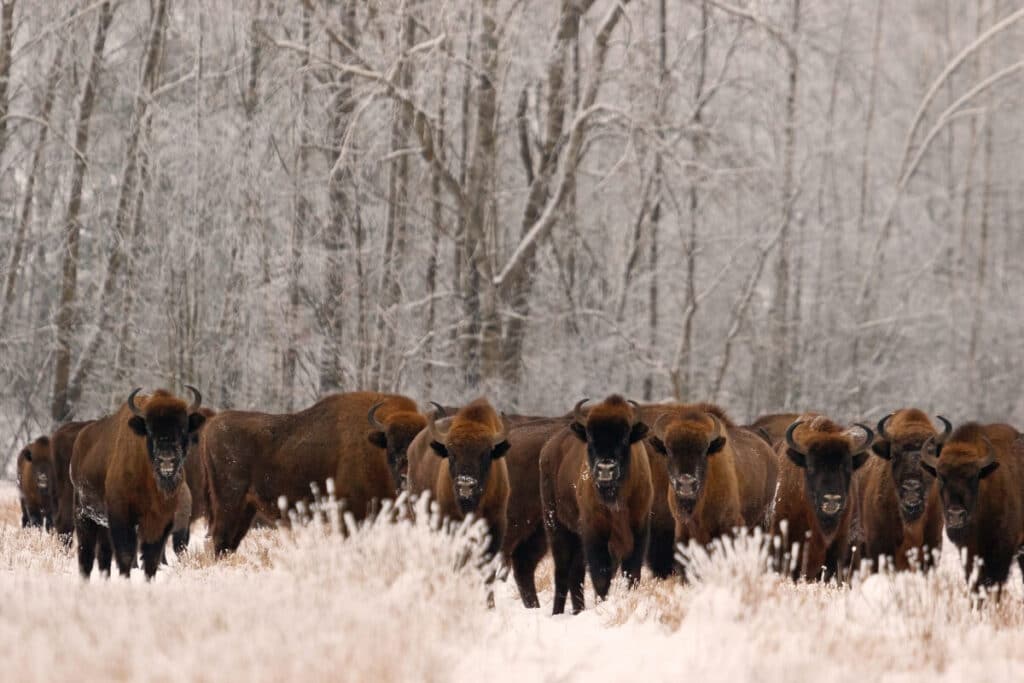
This high-profile success is encouraging proof of the impact conservation can have when given enough investment and resources. Road maps such as these are all the more important as the extinction crisis accelerates: in this year’s Red List update, 31 species were officially announced extinct. These included 15 species of unique fish found only in Lake Lanao in the Philippines, whose demise came about due to invasive species, destructive fishing methods and overfishing.
Also on the extinction list are three Central American frog species, who have been wiped out by the devastating chytridiomycosis disease: a fungal infection rapidly spreading across the world’s amphibians, possibly exacerbated by climate change. Fortunately, efforts to protect critical habitats are helping several other amphibian species to recover. Among them is the Oaxaca Treefrog Sarcohyla celata, which moved from Critically Endangered to Near Threatened this year thanks to the dedication of local communities in Mexico.
“The conservation successes in today’s Red List update provide living proof that the world can set, and meet, ambitious biodiversity targets. They further highlight the need for real, measurable commitments as we formulate and implement the post-2020 global biodiversity framework,” said Dr Jane Smart, Global Director of IUCN’s Biodiversity Conservation Group.
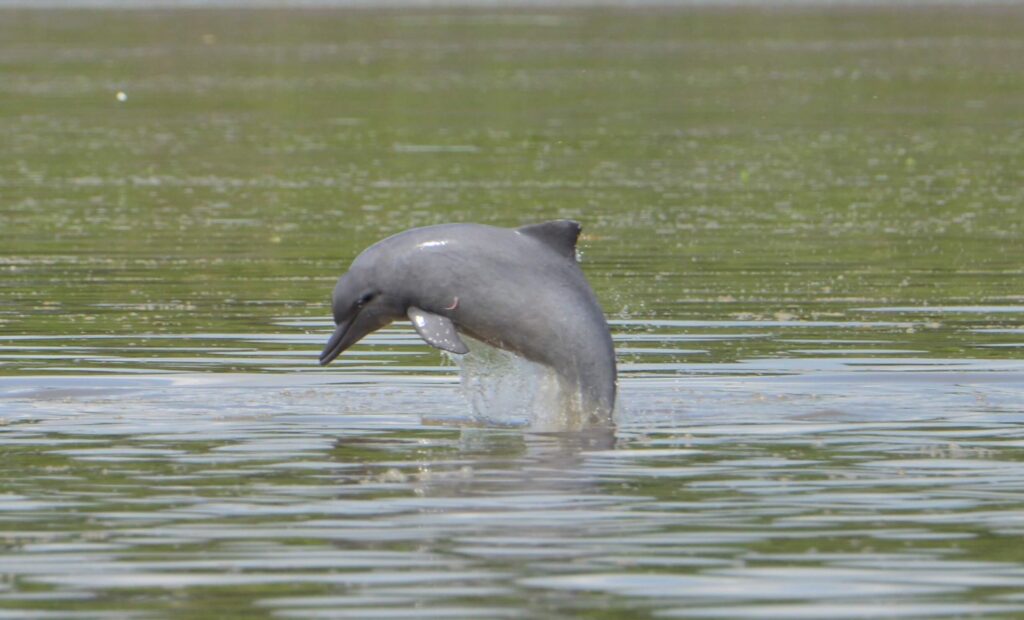
Preventing future extinctions needs to be a priority in the new global plan for nature. With the Tucuxi dolphin Sotalia fluviatilis moving from Data Deficient to Endangered this year, all of the world’s freshwater dolphin species are now listed as threatened. The Tucuxi, a small grey dolphin found in the Amazon river system, has been decimated by accidental “bycatch” in fishing gear, damming of rivers and pollution. Their recovery will require eliminating the use of gillnets – curtains of fishing net that hang in the water – reducing the number of dams, and enforcing the ban on the deliberate dolphin hunting.
Even something as solid and familiar as the oak tree is no longer safe from human pressures. This year, a comprehensive assessment of this group of trees reveals that nearly a third – 113 of 430 species – are threatened with extinction. Land clearance for agriculture and logging are the most common threats in China, Mexico and Southeast Asia. In the USA, however, invasive alien species, diseases and climate change are the main concerns.
While this news may sound dispiriting, the Red List is far from the death knell it may appear to be. Instead, it is an early warning system, guiding us to where action is needed most. Species classed as threatened become a rallying point for scientists, governments and communities to focus their efforts. The Red List is far from an end point – in fact, it’s where it all begins.
In December 2020, BirdLife unveiled this year’s Red List ups and downs – with mixed results for the world’s birds.
By Lewis Kihumba
Forming part of the Ethiopian Highlands in Southern Ethiopia is the Liben Plain, an Important Bird and Biodiversity Area. These plains hold one of only two known populations of the Critically Endangered Liben Lark Heteromirafra archeri, one of the oldest species of lark in the world, with only 50 to 100 individuals surviving today. Over the years, the Liben Plain has seen numerous human pressures. Population growth, overgrazing, in addition to drought and soil erosion among others, has meant that only a small fraction of the grasslands remain, much of it degraded. In turn, this has led to the fragmentation of the Liben Lark’s habitat, splitting populations from each other and putting additional pressure on this bird.
In 2015, Birdlife International, RSPB, Ethiopia Wildlife and Natural History Society (BirdLife Partner) and SOS Sahel Ethiopia, embarked on a three year project to save the Liben Lark. The Darwin funded project helped local communities create four communally managed grasslands reserves known as kallos across the plain. The kallos managed by local pastoralists’ communities, would serve as fodder for livestock during the dry season. Most importantly, the kallos would provide suitable breeding and foraging for the lark during the two wet seasons locally known as Ganna and Hagaya.
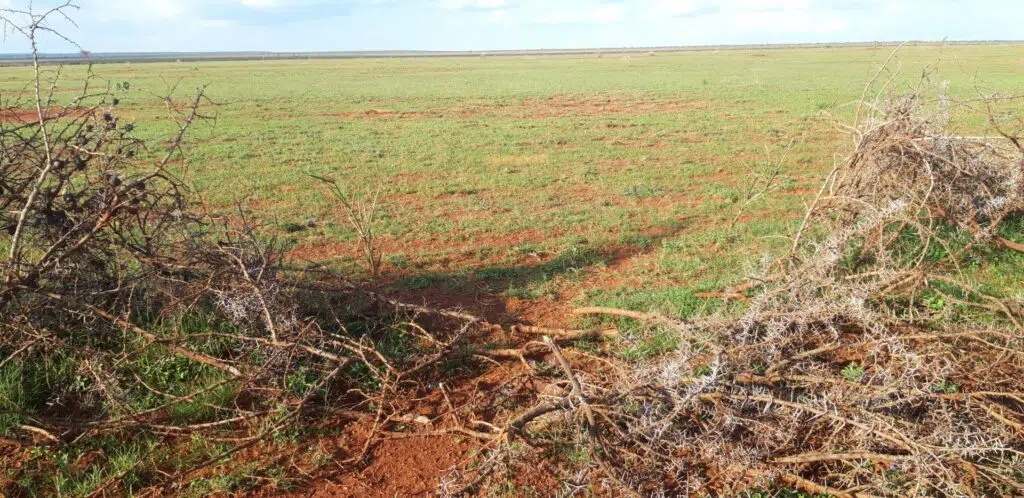
In addition to supporting the pastoralism activities, the project was also designed to help vulnerable households to diversify their livelihoods from extensive pastoralism and therefore reduce their needs and pressure on grasslands. A savings and credit co-operative was formed with four village level Community Based Organizations (CBOs). Currently, the co-operative has over 100 members and training is being provided.
The project had mixed results at the start. Between 2015 and 2017, severe drought in southern Ethiopia coupled with political instability negatively impacted the kallos. In 2018, when the project was due to come to an end, the reserves experienced an upturn following good rains in the region. A field trip undertaken by the project partners in the same year, found out that although the kallos were full of lush grass, the number of Liben Lark territories were fewer than envisaged.
There’s still hope though. The birds could have been wiped out due to the drought, but have held on. In 2019, a second survey yielded positive results and found that the number of Liben Larks had increased from 11 to 21 territories, although in a declining range on the plain. The kallos have also been instrumental in supporting local pastoralists, providing 70% of fodder during the drought period to more than 900 households. After the good weather in 2018, two of the existing kallo were extended. “We got relatively good season for grasses and we recommend that kallo maintenance and new kallo establishments continue”, said one community elder.
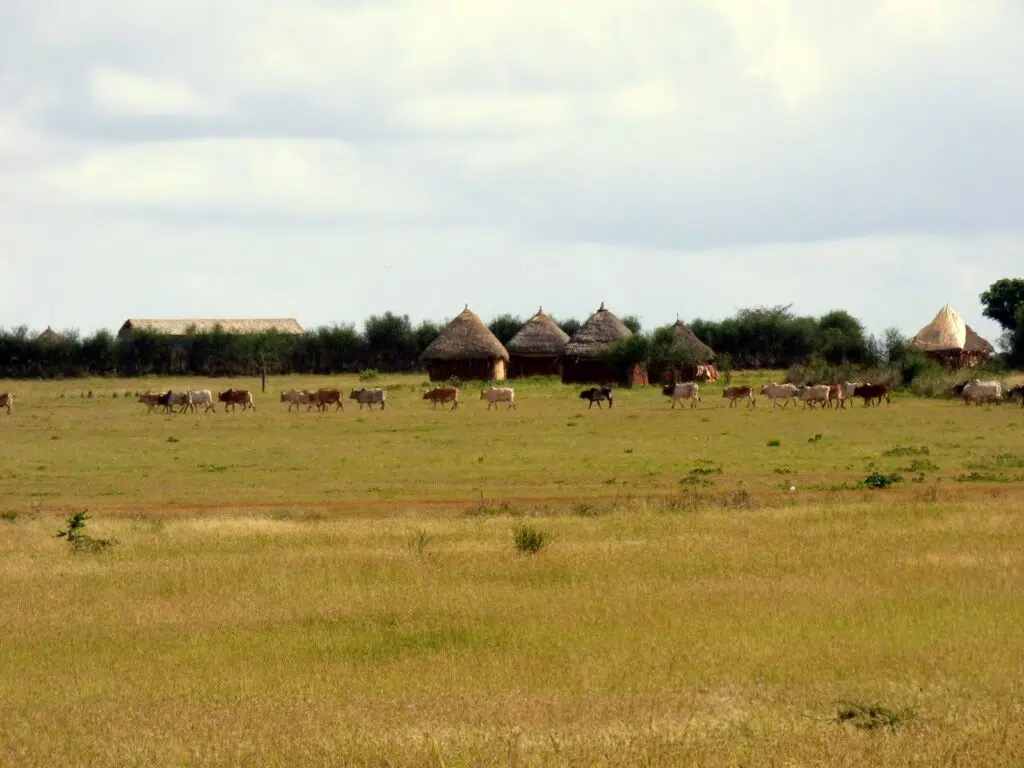
Thankfully, the project has continued beyond 2019 with emergency response funding from RSPB and a grant from the IUCN Save Our Species, co-funded by the European Union. This means that maintenance of these vital kallos protecting both bird and livelihoods, can continue. While sustainable land management of the Liben Plains has been initiated, focus is now on long term solutions which will build on these conservation efforts to halt degradation of the Liben Plain and thus save mainland Africa’s first bird threatened with extinction.
This publication was produced with the financial support of the European Union through IUCN Save Our Species. Its contents are the sole responsibility of BirdLife International, RSPB, Ethiopian Wildlife and Natural History Society and SOS Sahel, and do not necessarily reflect the views of IUCN or the European Union.
Sign up to receive the latest bird conservation news. You’ll also receive updates about our projects, science and other ways to get involved including fundraising.
Thank you for your support, we are committed to protecting your personal information and privacy. For more information on how we use your data, please see our Privacy Policy. You can unsubscribe from emails at any time by using the link in the footer of any email from us.


By Vincent Otieno
With their hunched posture, bald heads and their use in cartoons to represent opportunistic greed, vultures are arguably the most misunderstood scavengers. Humans have long considered them to be the outcasts of the animal kingdom, and due to their association with death, they are feared and reviled. Yet, their swift response means carcasses are picked clean before disease particles can take hold.
As large birds of open grassland and dryland habitats, vultures are social in nature and travel over vast areas. As well as having intrinsic value as living beings, they keep habitats free of carcasses and waste, and are arguably nature’s most important scavengers. However, this scenario is fast changing as Africa’s vultures are disappearing at a devastating rate. Today, vultures are among the most threatened group of birds worldwide.
Seven of Africa’s eleven vulture species now find themselves on the edge of extinction, and their decline has been alarmingly rapid over the last 50 years: numbers have fallen by 80-97 per cent depending on the species. There are eight vulture species in Kenya. Four of these, namely the White-backed Vulture Gyps africanus, Rüppell’s Vulture Gyps rueppelli, White-headed Vulture Trigonoceps occipitalis and Hooded Vulture Necrosyrtes monachus, are considered Critically Endangered on the IUCN Red List of threatened species.
Poisoning is a major aspect of human-wildlife conflict in Kenya. In some areas of Kajiado county, particularly those bordering wildlife conservation areas, more than 60% of vulture deaths are due to poisoning. When a predator such as a lion, hyena, leopard attacks and kills cattle, herders retaliate by lacing a carcass with poison targeting the predator. Vultures, which are not the primary targets, are attracted to the poisoned carcass in large numbers.
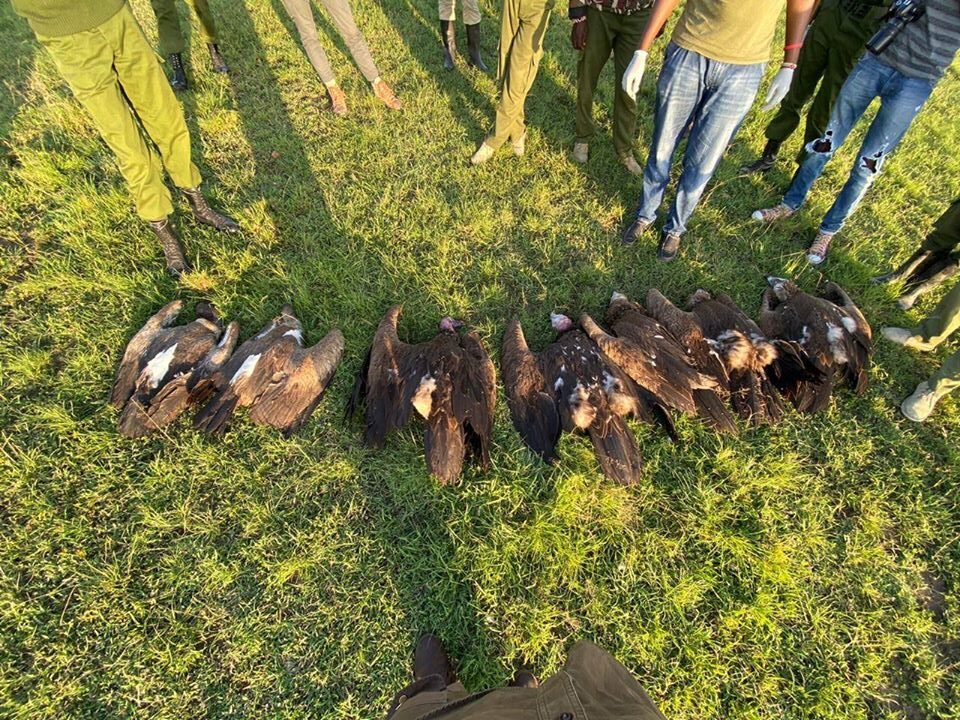
Since August 2019, three wildlife poisoning incidents have been reported, accounting for the death of 54 vultures. In the most recent incident, seven vultures died at the Olerai conservancy, Narok County after they fed on a hyena carcass that was laced with poison. The surviving White-backed Vulture was airlifted to Olderkesi Conservancy where a rehabilitation centre has been set up.
Since August 2019, three wildlife poisoning incidents have been reported, accounting for the death of 54 vultures. In the most recent incident, seven vultures died at the Olerai conservancy, Narok County after they fed on a hyena carcass that was laced with poison. The surviving White-backed Vulture was airlifted to Olderkesi Conservancy where a rehabilitation centre has been set up.
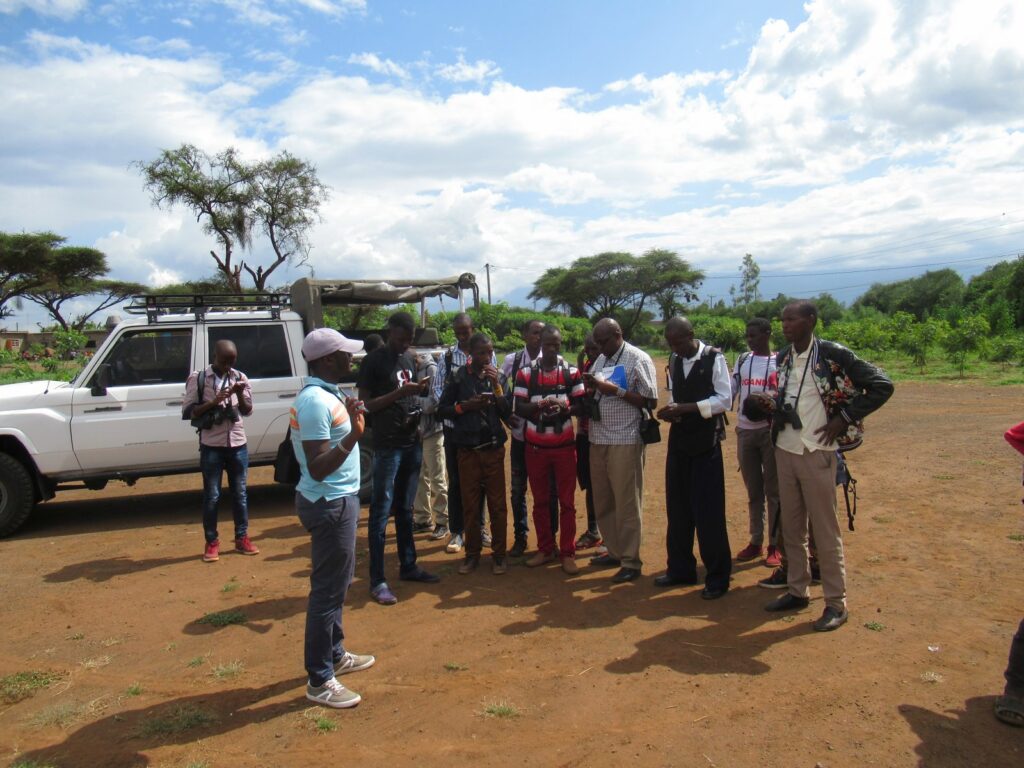
In the first incident, back in August 2019, 30 vultures died after consuming a giraffe carcass that had been laced with poison. These poisoning incidents have continued to spark outrage among members of the public, with some taking to social media to express their displeasure at the manner in which the birds are being wiped out through poisoning. Others are calling for rigorous education of communities bordering conservation sites on the importance of vultures to the ecosystem.
Nature Kenya has been instrumental in conserving vultures in the rangelands. To help curb deaths by poisoning, the organization is engaging communities by employing a community awareness approach with the help Vulture Liaison Officers and Vulture Volunteers, who are well-distributed across Kenya’s southern rangelands. The Vulture Volunteers are located at human-wildlife conflict hotspots, in order to help create awareness on the negative impact of wildlife poisoning and educate the community about the importance of vultures in the ecosystem. They also act as first respondents when poisoning cases are reported, as well as reporting wildlife poisoning incidents to authorities.
Sign up to receive the latest bird conservation news. You’ll also receive updates about our projects, science and other ways to get involved including fundraising.
Thank you for your support, we are committed to protecting your personal information and privacy. For more information on how we use your data, please see our Privacy Policy. You can unsubscribe from emails at any time by using the link in the footer of any email from us.

